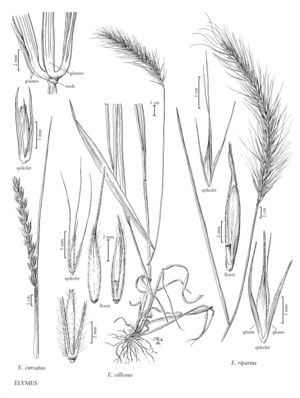Difference between revisions of "Elymus villosus"
FNA>Volume Importer |
FNA>Volume Importer |
||
| Line 23: | Line 23: | ||
-->{{Treatment/Body | -->{{Treatment/Body | ||
|distribution=W.Va.;Del.;D.C;Wis.;Ont.;Que.;Kans.;Mo.;N.Dak.;Nebr.;Okla.;S.Dak.;Wyo.;N.J.;N.Y.;Tenn.;N.C.;S.C.;Pa.;R.I.;Conn.;Mass.;Vt.;Va.;Miss.;Ala.;Ark.;Ill.;Ga.;Ind.;Iowa;Tex.;Md.;Ohio;Minn.;Mich.;Ky. | |distribution=W.Va.;Del.;D.C;Wis.;Ont.;Que.;Kans.;Mo.;N.Dak.;Nebr.;Okla.;S.Dak.;Wyo.;N.J.;N.Y.;Tenn.;N.C.;S.C.;Pa.;R.I.;Conn.;Mass.;Vt.;Va.;Miss.;Ala.;Ark.;Ill.;Ga.;Ind.;Iowa;Tex.;Md.;Ohio;Minn.;Mich.;Ky. | ||
| − | |discussion=<p | + | |discussion=<p>Elymus villosus grows in moist to moderately dry, often rocky soils in woods and thickets, especially in calcareous or other base-rich soils, but it is also frequent on drier, sandy soils or damper, alluvial soils in glaciated regions. It extends from the Great Plains east to southern Quebec, northern New York, and Vermont south to Texas, Georgia, and South Carolina. It is absent from the southern portion of the coastal plain.</p><!-- |
| − | --><p | + | --><p>Elymus villosus is relatively uniform and distinct, although it has sometimes been confused with hairy plants of E. canadensis (p. 303) and E. glabriflorus (p. 296). The hairs of E. villosus are fine, whitish, and consistently dense on the leaf blades, typically spreading in the spikelets; the hairs of the other species are typically stouter and more appressed in the spikelets. Plants called E. villosus var. arkansanas (Scribn. & C.R. Ball) J.J.N. Campb. are scabrous to glabrous in the spikes, except for the ciliate rachis margins, and often more robust. These are scattered over much of the species' range, except in the north (from Wisconsin to New England), and are locally more frequent than typical plants in the Ozark Mountains and other midwestern hills. Some other western plants (including those called E. striatus var. ballii Pammel) have unusually large, almost erect spikes, suggesting introgression from E. virginicus (p. 298). There are rare apparent hybrids with species in the E. virginicus group, but the only proven natural hybrid is with Hordeum fubatum (p. 245) (see *Elyhordeum, p. 283). Artificial crosses with several species failed to produce healthy Fj plants (Church 1958).</p> |
|tables= | |tables= | ||
|references= | |references= | ||
| Line 40: | Line 40: | ||
|basionyms= | |basionyms= | ||
|family=Poaceae | |family=Poaceae | ||
| + | |illustrator=Cindy Roché and Annaliese Miller | ||
|distribution=W.Va.;Del.;D.C;Wis.;Ont.;Que.;Kans.;Mo.;N.Dak.;Nebr.;Okla.;S.Dak.;Wyo.;N.J.;N.Y.;Tenn.;N.C.;S.C.;Pa.;R.I.;Conn.;Mass.;Vt.;Va.;Miss.;Ala.;Ark.;Ill.;Ga.;Ind.;Iowa;Tex.;Md.;Ohio;Minn.;Mich.;Ky. | |distribution=W.Va.;Del.;D.C;Wis.;Ont.;Que.;Kans.;Mo.;N.Dak.;Nebr.;Okla.;S.Dak.;Wyo.;N.J.;N.Y.;Tenn.;N.C.;S.C.;Pa.;R.I.;Conn.;Mass.;Vt.;Va.;Miss.;Ala.;Ark.;Ill.;Ga.;Ind.;Iowa;Tex.;Md.;Ohio;Minn.;Mich.;Ky. | ||
|reference=None | |reference=None | ||
| Line 45: | Line 46: | ||
|publication year= | |publication year= | ||
|special status= | |special status= | ||
| − | |source xml=https:// | + | |source xml=https://bibilujan@bitbucket.org/aafc-mbb/fna-data-curation.git/src/314eb390f968962f596ae85f506b4b3db8683b1b/coarse_grained_fna_xml/V24/V24_424.xml |
|subfamily=Poaceae subfam. Pooideae | |subfamily=Poaceae subfam. Pooideae | ||
|tribe=Poaceae tribe Triticeae | |tribe=Poaceae tribe Triticeae | ||
Revision as of 16:07, 30 October 2019
Plants cespitose, not rhizomatous, often persistently deep green. Culms 40-130 cm, erect; nodes 4-8, concealed or exposed, glabrous. Leaves evenly distributed; sheaths villous-hirsute, pilose, or occasionally glabrate, occasionally reddish brown; auricles 1-3 mm, brownish; ligules shorter than 1 mm, entire or erose; blades 4-12 mm wide, lax, dark glossy green, adaxial surfaces usually densely velutinous-villous with fine whitish hairs, rarely pilose only on the veins. Spikes 4-12 cm long, 1.5-3.5 cm wide, slightly or strongly nodding, exserted, usually with 2 spikelets per node, rarely with 1 or 3 at a few nodes; internodes (1.5)2-3(4) mm long, 0.15-0.25 mm thick at the thinnest sections, usually hairy below the spikelets, rarely glabrous. Spikelets 7-12 mm, moderately divergent, with 1-2(3) florets, lowest florets functional; disarticulation above the glumes and beneath each floret. Glumes equal, 12-25 mm including the often undifferentiated awns, the basal 0.5-2 mm terete, slightly indurate, straight or nearly so, without evident venation, glume bodies 7-10 mm long, (0.2)0.3-0.8 mm wide, linear-setiform, widening or parallel-sided above the base, 2-3(4)-veined, usually hirsute to hispid, occasionally scabrous to scabridulous, margins firm, awns 5-15 mm, straight; lemmas 5.5-9 mm, usually villous with fine, whitish, spreading hairs, especially near the margins and apices, sometimes glabrous or with coarser hairs, sometimes scabrous, awns 9-33 mm, straight; paleas 5-7.5 mm, obtuse, occasionally emarginate; anthers (1.6)2-3(4) mm. Anthesis early June to early July. 2n = 28.
Distribution
W.Va., Del., D.C, Wis., Ont., Que., Kans., Mo., N.Dak., Nebr., Okla., S.Dak., Wyo., N.J., N.Y., Tenn., N.C., S.C., Pa., R.I., Conn., Mass., Vt., Va., Miss., Ala., Ark., Ill., Ga., Ind., Iowa, Tex., Md., Ohio, Minn., Mich., Ky.
Discussion
Elymus villosus grows in moist to moderately dry, often rocky soils in woods and thickets, especially in calcareous or other base-rich soils, but it is also frequent on drier, sandy soils or damper, alluvial soils in glaciated regions. It extends from the Great Plains east to southern Quebec, northern New York, and Vermont south to Texas, Georgia, and South Carolina. It is absent from the southern portion of the coastal plain.
Elymus villosus is relatively uniform and distinct, although it has sometimes been confused with hairy plants of E. canadensis (p. 303) and E. glabriflorus (p. 296). The hairs of E. villosus are fine, whitish, and consistently dense on the leaf blades, typically spreading in the spikelets; the hairs of the other species are typically stouter and more appressed in the spikelets. Plants called E. villosus var. arkansanas (Scribn. & C.R. Ball) J.J.N. Campb. are scabrous to glabrous in the spikes, except for the ciliate rachis margins, and often more robust. These are scattered over much of the species' range, except in the north (from Wisconsin to New England), and are locally more frequent than typical plants in the Ozark Mountains and other midwestern hills. Some other western plants (including those called E. striatus var. ballii Pammel) have unusually large, almost erect spikes, suggesting introgression from E. virginicus (p. 298). There are rare apparent hybrids with species in the E. virginicus group, but the only proven natural hybrid is with Hordeum fubatum (p. 245) (see *Elyhordeum, p. 283). Artificial crosses with several species failed to produce healthy Fj plants (Church 1958).
Selected References
None.
